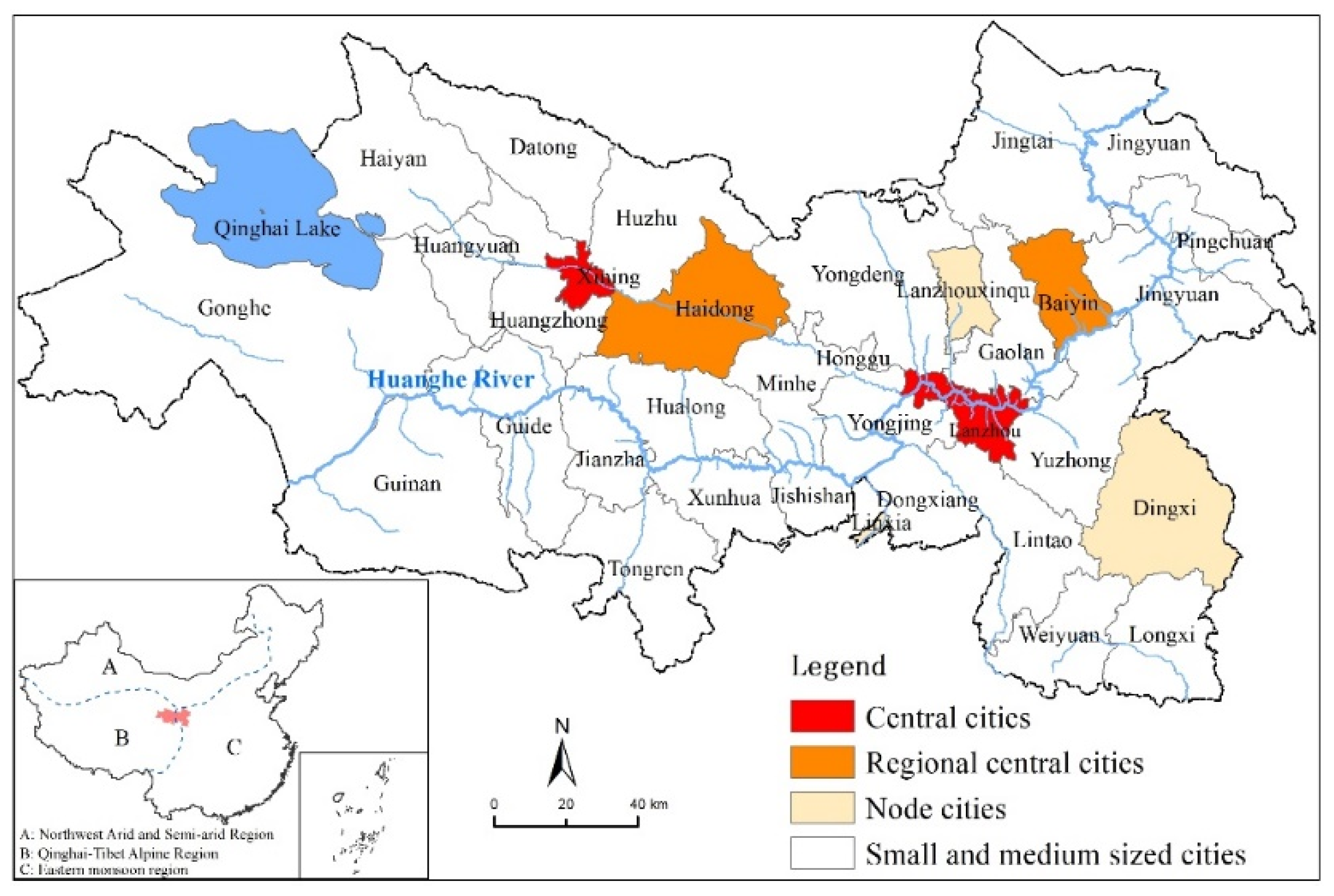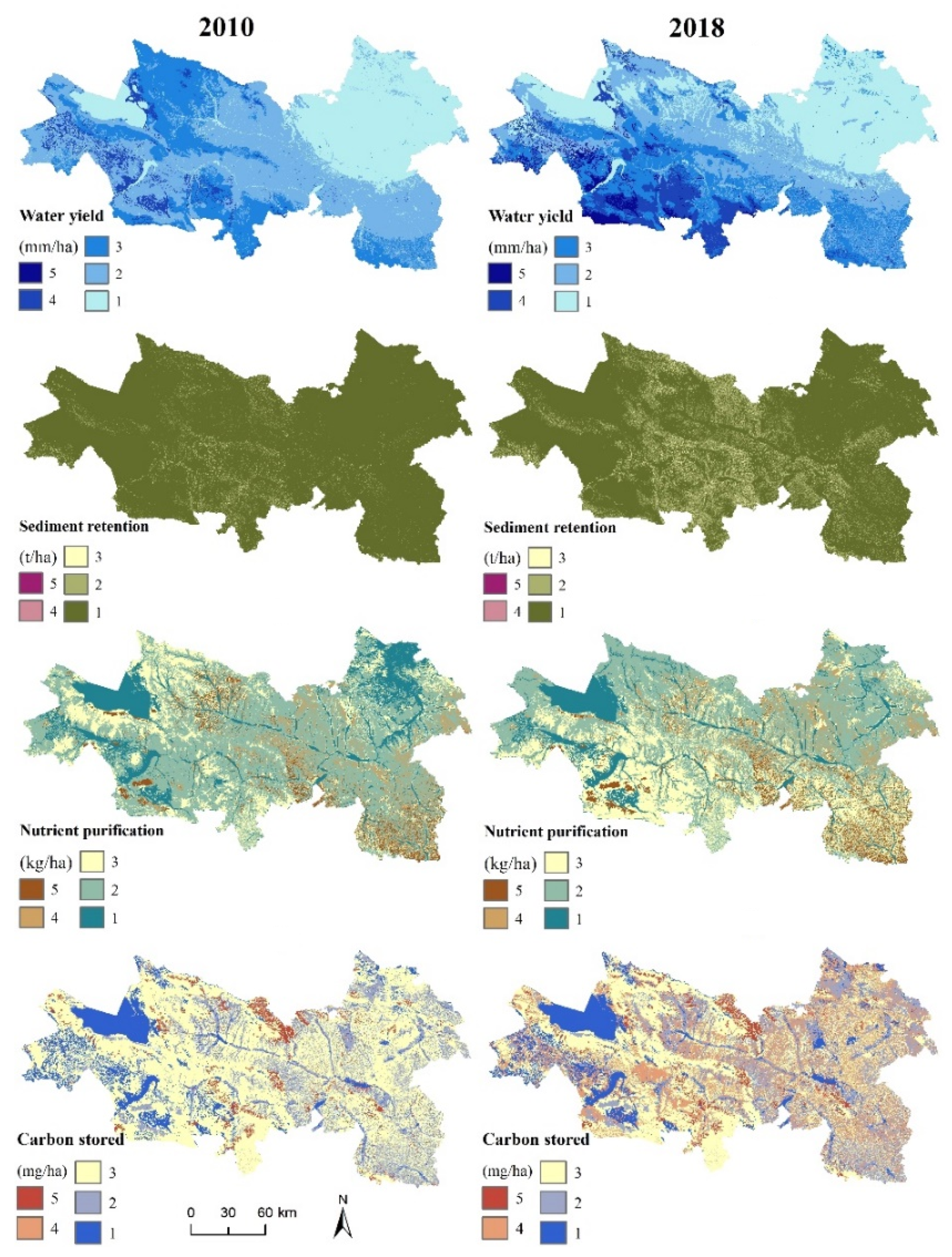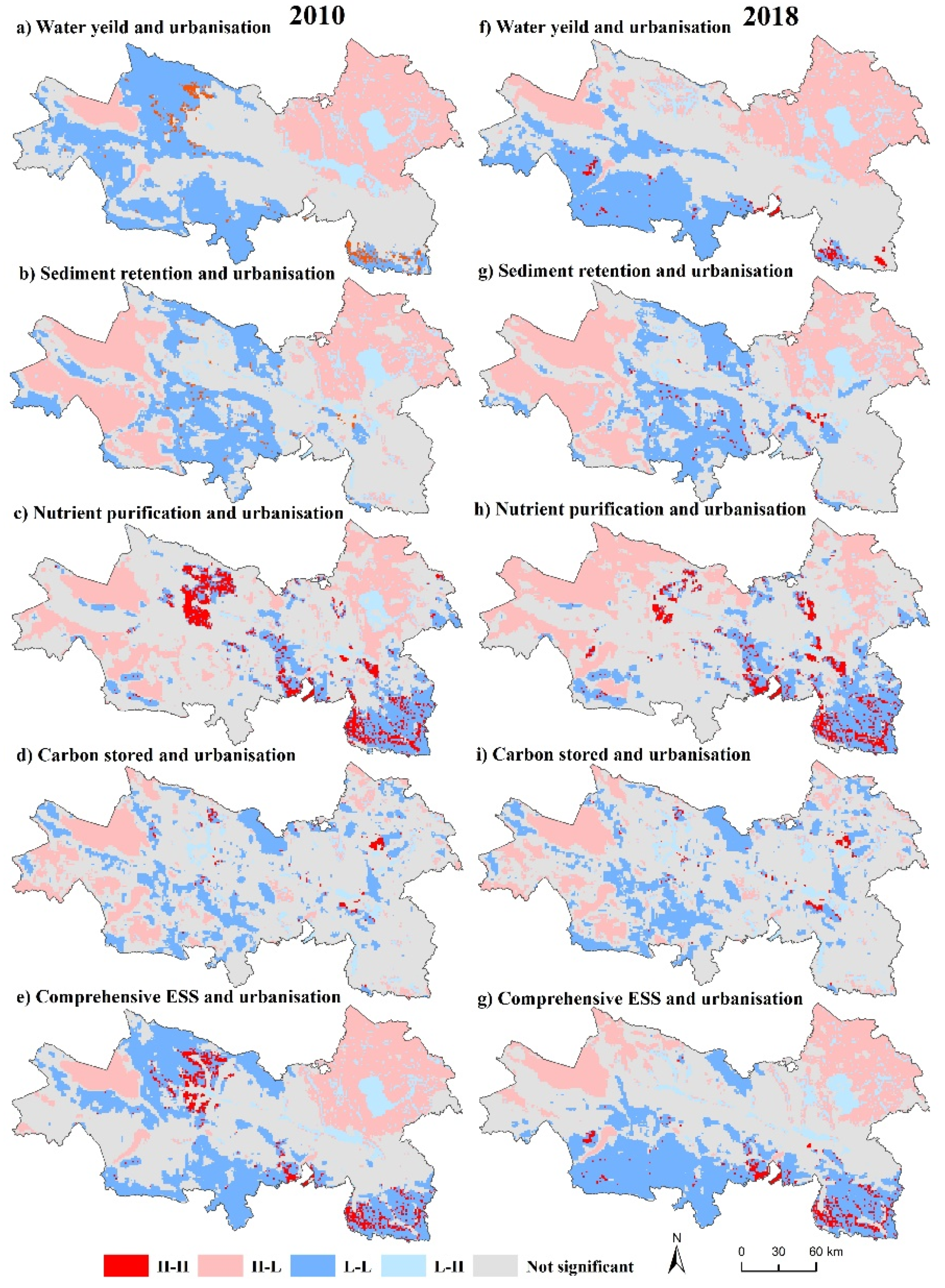Spatial–Temporal Interaction Relationship between Ecosystem Services and Urbanization of Urban Agglomerations in the Transitional Zone of Three Natural Regions
Abstract
1. Introduction
2. Materials and Methods
2.1. Study Area
2.2. Data Sources and Preparation
2.3. Methods
2.3.1. Analysis of Spatial–Temporal Interaction Relationships
2.3.2. Accounting for ESs
2.3.3. Measurement of Urbanization Level
3. Results
3.1. Spatial–Temporal Characteristics of ESs
3.2. Spatial–Temporal Characteristics of Urbanization Level
3.3. Spatial–Temporal Interaction Relationship between Urbanization and ESs
4. Discussion
4.1. The ESs of the LX Urban Agglomeration Gradually Improved
4.2. The Regional Spatial Heterogeneity of Urbanization Level was More Significant in the LX Urban Agglomeration
4.3. The Relationship between Urbanization and ESs
4.4. Suggestions for Coordinating Urban Development and Ecological Protection
4.5. Limitations and Future Perspectives
5. Conclusions
- (1)
- From 2010 to 2018, various ecosystem services in the LX urban agglomeration showed an overall upward trend. The overall distribution pattern of various ecosystem services is consistent, but the spatial differences are obvious. The central and regional center cities have the fewest ecosystem services, the node cities have relatively few ecosystem services, and the small and medium-sized cities have a relatively high number of ecosystem services.
- (2)
- In 2018 and 2010, the spatial distribution pattern of urbanization level in the LX urban agglomeration was basically the same, and the regional spatial differences were significant. The urbanization level is the highest in the central cities of Lanzhou and Xining, followed by the regional central cities.
- (3)
- The relationship between urbanization and ESs is complex. There is a negative correlation between urbanization and ESs in the LX urban agglomeration, and the degree of negative correlation between urbanization and ESs is heterogeneric. The spatial–temporal relationships between urbanization and water yield, sediment retention, and carbon storage are significantly negatively correlated, but the relationship between urbanization and nutrient purification is significantly positively correlated. Future effective measures should be taken to promote the rational population and economic development, to promote intensive and economical land use, and to achieve the sustainable development of cities.
Author Contributions
Funding
Conflicts of Interest
References
- Xu, X.Q.; Zhou, Y.X.; Ning, Y.M. Urban Geography; Higher Education Press: BeiJing, China, 2009; pp. 52–84. [Google Scholar]
- Bowen, J.L.; Valiela, I. The ecological effcts of urbanization of coastal watersheds: Historical increases in nitrogen loads and eutrophication of Waquoit Bay estuaries. Can. J. Fish. Aquat. Sci. 2001, 58, 1489–1500. [Google Scholar] [CrossRef]
- Beach, D. Coastal Sprawl: The Effcts of Urban Design on Aquatic Ecosystems of the United States. Pew Oceans Comm. 2002. [Google Scholar]
- Mentens, J.; Raes, D.; Hermy, M. Green roofs as a tool for solving the rainwater run of problem in the urbanized 21st century? Landsc. Urban Plan. 2006, 77, 217–226. [Google Scholar] [CrossRef]
- Qiu, G.Y.; Zhang, N. China’s urbanization and its ecological environment challenges in the 21st century. Prog. Geogr. 2019, 34, 640–649. [Google Scholar]
- Du, X.; Meng, Y.R.; Fang, C.L.; Li, C. Spatio-temporal characteristics of coupling coordination development between urbanization and eco-environment in Shandong Peninsula urban agglomeration. Acta. Ecol. Sin. 2020, 40, 5546–5559. [Google Scholar]
- Elmqvist, T.; Fragkias, M.; Goodness, J.; Güneralp, B.; Marcotullio, P.J.; McDonald, R.I.; Parnell, S.; Schewenius, M.; Sendstad, M.; Seto, K.C.; et al. Urbanization, Biodiversity and Ecosystem Services: Challenges and Opportunities; Springer: Berlin/Heidelberg, Germany, 2013; pp. 31–52. [Google Scholar]
- Seto, K.C.; Fragkias, M.; Güneralp, B.; Reilly, M.K. A Meta-Analysis of Global Urban Land Expansion. PLoS ONE 2011, 6, e23777. [Google Scholar] [CrossRef] [PubMed]
- Deng, X.; Huang, J.; Rozelle, S.; Zhang, J.; Li, Z. Impact of urbanization on cultivated land changes in China. Land Use Policy 2015, 45, 1–7. [Google Scholar] [CrossRef]
- Wu, Y.; Zhang, X.; Shen, L. The impact of urbanization policy on land use change: Ascenario analysis. Cities 2011, 28, 147–159. [Google Scholar] [CrossRef]
- Zope, P.; Eldho, T.I.; Jothiprakash, V. Impacts of land use–land cover change and urbanization on flooding: A case study of Oshiwara River Basin in Mumbai, India. Catena 2016, 145, 142–154. [Google Scholar] [CrossRef]
- Xu, Q.; Yang, R.; Dong, Y.-X.; Liu, Y.-X.; Qiu, L.-R. The influence of rapid urbanization and land use changes on terrestrial carbon sources/sinks in Guangzhou, China. Ecol. Indic. 2016, 70, 304–316. [Google Scholar] [CrossRef]
- Roberts, A.D.; Prince, S.D.; Jantz, C.A.; Goetz, S.J. Effects of projected future urbanland cover on nitrogen and phosphorus runoff to Chesapeake Bay. Ecol. Eng. 2009, 35, 1758–1772. [Google Scholar] [CrossRef]
- Seto, K.C.; Güneralp, B.; Hutyra, L.R. Global forecasts of urban expansion to 2030 and direct impacts on biodiversity and carbon pools. Proc. Natl. Acad. Sci. USA 2012, 109, 16083–16088. [Google Scholar] [CrossRef]
- Yuan, Y.; Wu, S.; Yu, Y.; Tong, G.; Mo, L.; Yan, D.; Li, F. Spatiotemporal interaction between ecosystem services and urbanization: Case study of Nanjing City, China. Ecol. Indic. 2018, 95, 917–929. [Google Scholar] [CrossRef]
- Alberti, M. Maintaining ecological integrity and sustaining ecosystem function inurban areas. Curr. Opin. Environ. Sustain. 2010, 2, 178–184. [Google Scholar] [CrossRef]
- Liu, J.; Li, J.; Qin, K.; Zhou, Z.; Yang, X.; Li, T. Changes in land-uses and ecosystem sevices under multi-scenarios simulation. Sci. Total Environ. 2017, 586, 522–526. [Google Scholar] [CrossRef] [PubMed]
- Song, Y.Y.; Xue, D.Q.; Ma, P.P.; Yang, K.Y.; Mi, W.B. Urbanization Process and Its Ecological Environment Response Pattern on the Loess Plateau. China Econ. Geogr. 2020, 40, 174–184. [Google Scholar]
- Breuste, J.; Qureshi, S. Urban sustainability, urban ecology and the Society for Urban Ecology (SURE). Urban Ecosyst. 2011, 14, 313–317. [Google Scholar] [CrossRef]
- Breuste, J.; Qureshi, S.; Li, J. Applied urban ecology for sustainable urban environment. Urban Ecosyst. 2013, 16, 675–680. [Google Scholar] [CrossRef]
- Taylor, L.; Hochuli, D.F. Creating better cities: How biodiversity and ecosystem functioning enhance urban residents’ wellbeing. Urban Ecosyst. 2015, 18, 747–762. [Google Scholar] [CrossRef]
- Ran, S.-H.; Lü, C.-H.; Jia, K.-J.; Qi, Y.-H. Environmental impact assessment of the land use change in china based on ecosystem service value. Huan Jing ke Xue = Huanjing Kexue 2006, 27, 2139–2144. [Google Scholar]
- Amundson, R.; Berhe, A.A.; Hopmans, J.W.; Olson, C.; Sztein, A.E.; Sparks, D.L. Soil and human security in the 21st century. Science 2015, 348, 1261071. [Google Scholar] [CrossRef] [PubMed]
- Huang, B.L.; Zhang, J. Coordination between population development and economic structure based on the land in Xijiang. J. Arid Land. Resour. Environ. 2012, 26, 175–180. [Google Scholar]
- Peng, J.; Tian, L.; Liu, Y.; Zhao, M.; Hu, Y.; Wu, J. Ecosystem services response to urbanization in metropolitan areas: Thresholds identification. Sci. Total Environ. 2017, 607, 706–714. [Google Scholar] [CrossRef] [PubMed]
- Fang, C.L.; Cui, X.G.; Liang, L.W. Theoretical analysis of urbanization and eco-environment coupling coil and coupler control. Acta Geogr. Sin. 2019, 74, 2529–2546. [Google Scholar]
- Lin, Y.Y.; Qiu, R.Z.; Yao, J.X.; Jin, G.L. The effects of urbanization on China’s forest loss from 2000 to 2012: Evidence from a panel analysis. J. Clean Prod. 2019, 214, 270–278. [Google Scholar] [CrossRef]
- Wang, Y.; Luo, X.; Chen, W.; Zhao, M.; Wang, B. Exploring the spatial effect of urbanization on multi-sectoral CO2 emissions in China. Atmos. Pollut. Res. 2019, 10, 1610–1620. [Google Scholar] [CrossRef]
- Lapointe, M.; Gurney, G.G.; Cumming, G.S. Urbanization alters ecosystem service preferences in a Small Island Developing State. Ecosyst. Serv. 2020, 43, 101109. [Google Scholar] [CrossRef]
- Zhao, Y.; Wang, S.; Ge, Y.; Liu, Q.; Liu, X. The spatial differentiation of the coupling relationship between urbanization and the eco-environment in countries globally: A comprehensive assessment. Ecol. Model. 2017, 360, 313–327. [Google Scholar] [CrossRef]
- Cai, D.; Fraedrich, K.; Guan, Y.; Guo, S.; Zhang, C. Urbanization and the thermal environment of Chinese and US-American cities. Sci. Total Environ. 2017, 589, 200–211. [Google Scholar] [CrossRef]
- Sunde, M.G.; He, H.S.; Hubbart, J.A.; Urban, M.A. An integrated modeling approach for estimating hydrologic responses to future urbanization and climate changes in a mixed-use midwestern watershed. J. Environ. Manag. 2018, 220, 149–162. [Google Scholar] [CrossRef]
- Mascarenhas, A.; Haase, D.; Ramos, T.B.; Santos, R. Pathways of demographic and urban development and their effects on land take and ecosystem services: The case of Lisbon Metropolitan Area, Portugal. Land Use Policy 2019, 82, 181–194. [Google Scholar] [CrossRef]
- Reverte, F.C.; Garcia, M.D.G.M.; Brilha, J.B.; Pellejero, A.U. Assessment of impacts on ecosystem services provided by geodiversity in highly urbanised areas: A case study of the Taubaté Basin, Brazil. Environ. Sci. Policy 2020, 112, 91–106. [Google Scholar] [CrossRef]
- Balha, A.; Vishwakarma, B.D.; Pandey, S.; Singh, C.K. Predicting impact of urbanization on water resources in megacity Delhi. Remote. Sens. Appl. Soc. Environ. 2020, 20, 100361. [Google Scholar] [CrossRef]
- Li, S.C.; Zhao, Z.Q.; Wang, Y.L. Urbanization process and effects of natural resource and environment in china: Research trends and future direction. Prog. Geogr. 2009, 28, 63–70. [Google Scholar]
- Liu, Y.B.; Li, R.D. Scenario Simulation of Future Urbanization and Its Resource & Environment Effects in Jiangsu Province. Geogr. Geo-Infor. Sci. 2007, 23, 61–64. [Google Scholar]
- Liu, H.M.; Fang, C.L.; Li, Y.H. The Coupled human and natural cube: A conceptual framework for analyzing urbanization and eco-environment interactions. Acta Geogr. Sin. 2019, 74, 1489–1507. [Google Scholar]
- Fang, C.L.; Wang, Z.B.; Ma, H.T. The theoretical cognition of the development law of China’s urban agglomeration and academic contribution. Acta Geogr. Sin. 2018, 73, 651–665. [Google Scholar]
- Lang, W.L.; Wang, Z.B.; Sun, Z. Spatiotemporal differentiation and coordinated development pattern of urbanization and the ecological environment of the Beijing-Tianjin-Hebei urban agglomeration. Acta Ecol. Sin. 2019, 39, 1212–1225. [Google Scholar] [CrossRef]
- Chen, X.F.; Guo, J.F.; Yao, S.M. Study on the Coupling Between Ecological Capacity and New Urbanizationin Yangtze River Delta Agglomeration: Based on the Leopold’s Earth Ethics. Res. Envir. Yangtze Basin 2018, 27, 7157–7224. [Google Scholar]
- Wu, Z.X.; Zhang, Q.; Song, C.Q.; Zhang, F.; Zhu, X.D.; Sun, P.; Fan, K.K.; Yu, H.Q.; Shen, Z.X. Impacts of urbanization on spatio-temporal variations of temperature over the Pearl River Delta. Acta Geogr. Sin. 2019, 74, 2342–2357. [Google Scholar]
- Montgomery, M. World Bank: World Development Report 2009: Reshaping Economic Geography. Popul. Dev. Rev. 2009, 35, 197–200. [Google Scholar] [CrossRef]
- Smeraldo, S.; Bosso, L.; Fraissinet, M.; Bordignon, L.; Brunelli, M.; Ancillotto, L.; Russo, D. Modelling risks posed by wind turbines and power lines to soaring birds: The black stork (Ciconia nigra) in Italy as a case study. Biodivers. Conserv. 2020, 29, 1959–1976. [Google Scholar] [CrossRef]
- Hu, M.; Li, Z.; Yuan, M.; Fan, C.; Xia, B. Spatial differentiation of ecological security and differentiated management of ecological conservation in the Pearl River Delta, China. Ecol. Indic. 2019, 104, 439–448. [Google Scholar] [CrossRef]
- Fan, J.; Wang, Y.F.; Liang, B. The evolution process and regulation of China’s regional development pattern. Acta Geogr. Sin. 2019, 74, 2437–2454. [Google Scholar]
- Huang, B.W. The integrated nature division draft of China. Chin. Sci. Bull. 1959, 4, 594–602. [Google Scholar]
- Li, Y.; Zhu, G.R. Changes of climate zones in the transition area of three natural zones during the past 50 years and their responses to climate change. Adv. Earth Sci. 2015, 30, 791–801. [Google Scholar]
- Xu, J.H. Mathematical Methods in Contemporary Geography (Third Edition). China HEP 2017, 149–154. [Google Scholar]
- Ou, Y.X.; Zhu, X.; He, Y.Q. Spatial interaction between urbanisation and ecosystem services: A case study in Changsha-Zhuzhou-Xiangtan urban agglomeration, China. Acta Ecol. Sin. 2019, 39, 7502–7513. [Google Scholar] [CrossRef]
- Wu, N.; Song, X.Y.; Kang, W.H.; Deng, X.H.; Hu, X.Q.; Shi, P.J.; Liu, Y.Q. Standard of payment for ecosystem services in a watershed based on InVEST model under different standpoints: A case study of the Weihe River in Gansu Province. Acta Ecol. Sin. 2018, 38, 2512–2522. [Google Scholar] [CrossRef][Green Version]
- Chuai, X.W.; Huang, X.J.; Zheng, Z.Q.; Zhang, M.; Liao, Q.L.; Lai, L.; Lu, J.Y. Land use change and its influence on carbon storage of terrestrial ecosystems in jiangsu Province. Res. Sci. 2011, 33, 1932–1939. [Google Scholar]
- Ke, X.L.; Tang, L.P. Impact of cascading processes of urban expansion and cropland reclamation on the ecosystem of a carbon storage service in Hubei Province, China. Acta Ecol. Sin. 2019, 39, 672–683. [Google Scholar] [CrossRef]
- Chen, W.X.; Liu, Z.L.; Li, J.F.; Ran, R.; Zeng, J. Mapping the spatial relationship between ecosystem services and urbanization in the middle reaches of the Yangtze River Urban Agglomerations. Acta Ecol. Sin. 2020, 40, 5137–5150. [Google Scholar]
- Zeng, H.; Yan, C.H.; Huang, W.B.; Lin, Q.Y.; Yu, L.Y.; Qiu, G.Y. A case study on the relationship between urbanization level and water use efficiency in the pearl river delta urban agglomeration. Acta Sci. Nat. U Pekin. 2020, 56, 561–570. [Google Scholar]
- Ouyang, Z.; Zheng, H.; Xiao, Y.; Polasky, S.; Liu, J.; Xu, W.; Wang, Q.; Zhang, L.; Rao, E.; Jiang, L.; et al. Improvements in ecosystem services from investments in natural capital. Science 2016, 352, 1455–1459. [Google Scholar] [CrossRef] [PubMed]
- Viña, A.; McConnell, W.J.; Yang, H.; Xu, Z.; Liu, J. Effects of conservation policy on China’s forest recovery. Sci. Adv. 2016, 2, e1500965. [Google Scholar] [CrossRef] [PubMed]
- Jiang, W.; Deng, Y.; Tang, Z.; Lei, X.; Chen, Z. Modelling the potential impacts of urban ecosystem changes on carbon storage under different scenarios by linking the CLUE-S and the InVEST models. Ecol. Model. 2017, 345, 30–40. [Google Scholar] [CrossRef]
- Chen, Q.; Pu, L.; Liang, H.; Wen, J. Assessment of ecological environment of urbanland expansion in rapid urbanization area: A case study of Qixia District in Nanjing. Acta Agr. Univ. Jiangxien 2009, 31, 750–755. [Google Scholar]
- Zhang, Y.; Liu, Y.; Zhang, Y.; Liu, Y.; Zhang, G.; Chen, Y. On the spatial relationship between ecosystem services and urbanization: A case study in Wuhan, China. Sci. Total Environ. 2018, 637, 780–790. [Google Scholar] [CrossRef]
- Du, X.; Huang, Z. Ecological and environmental effects of land use change in rapid urbanization: The case of hangzhou, China. Ecol. Indic. 2017, 81, 243–251. [Google Scholar] [CrossRef]
- Wang, J.; Zhou, W.; Pickett, S.T.; Yu, W.; Li, W. A multiscale analysis of urbanization effects on ecosystem services supply in an urban megaregion. Sci. Total Environ. 2019, 662, 824–833. [Google Scholar] [CrossRef]




| Ecosystem Service | Key Parameters | Data Sources | Raw Data | Data Processing Method |
|---|---|---|---|---|
| Water yield | Annual precipitation | China Meteorological Science Data Sharing Service Network | Daily precipitation | Cokriging interpolation |
| Average annual reference evapotranspiration | Wind speed, relative humidity, temperature, sunshine duration, etc. | Penman model, cokriging interpolation | ||
| Plant available water content | World Soil Database | Soil texture data | Soil AWC (the volumetric (mm) plant available water content) estimation model | |
| Root restricting layer depth | Soil depth point data | Cokriging interpolation | ||
| Land use | Resource and Environment data center of Chinese Academy of Sciences | —— | Resample to 100 × 100 m | |
| Sub watersheds | USGS website | DEM data | Hydrology module in GIS | |
| Zhang constant | Hydrological station | Observations of annual evapotranspiration and water production | After much debugging, the simulation effect is the best when Z constant is 30 | |
| Sediment delivery ratio model | Rainfall erosivity index (R) | China Meteorological Science Data Sharing Service Network | Daily precipitation | Westheimer method |
| Soil erodibility (K) | World Soil Database | Soil texture data | Williams method | |
| Threshold flow accumulation value | USGS website | DEM data | When the threshold is 1500, the generated river network is more consistent with the actual water system | |
| Nutrient delivery ratio model | Nutrient runoff proxy | China Meteorological Science Data Sharing Service Network | Daily precipitation | Cokriging interpolation |
| Carbon storage and sequestration | Carbon pools | Related literature [42,43], IPCC (Intergovernmental Panel on Climate Change) (2006) | Carbon density data | Collect and sort |
| ESs | Water Yield (m3) | Sediment Retention (t) | Nutrient Purification (t) | Carbon Stored (t) |
|---|---|---|---|---|
| 2010 | 122.69 × 108 | 68.08 × 108 | 0.29 × 108 | 11.85 × 108 |
| 2018 | 150.84 × 108 | 171.26 × 108 | 0.34 × 108 | 12.54 × 108 |
| changes | 28.15 × 108 | 103.18 × 108 | 0.05 × 108 | 0.69 × 108 |
| Years | Urbanization and Water Yield | Urbanization and Sediment Retention | Urbanization and Nutrient Purification | Urbanization and Carbon Stored | Urbanization and Comprehensive Ecosystem Services |
|---|---|---|---|---|---|
| 2010 | −0.123 | −0.056 | 0.060 | −0.056 | −0.082 |
| 2018 | −0.104 | −0.051 | 0.061 | −0.100 | −0.090 |
Publisher’s Note: MDPI stays neutral with regard to jurisdictional claims in published maps and institutional affiliations. |
© 2020 by the authors. Licensee MDPI, Basel, Switzerland. This article is an open access article distributed under the terms and conditions of the Creative Commons Attribution (CC BY) license (http://creativecommons.org/licenses/by/4.0/).
Share and Cite
Pan, X.; Shi, P.; Wu, N. Spatial–Temporal Interaction Relationship between Ecosystem Services and Urbanization of Urban Agglomerations in the Transitional Zone of Three Natural Regions. Sustainability 2020, 12, 10211. https://doi.org/10.3390/su122310211
Pan X, Shi P, Wu N. Spatial–Temporal Interaction Relationship between Ecosystem Services and Urbanization of Urban Agglomerations in the Transitional Zone of Three Natural Regions. Sustainability. 2020; 12(23):10211. https://doi.org/10.3390/su122310211
Chicago/Turabian StylePan, Xiang, Peiji Shi, and Na Wu. 2020. "Spatial–Temporal Interaction Relationship between Ecosystem Services and Urbanization of Urban Agglomerations in the Transitional Zone of Three Natural Regions" Sustainability 12, no. 23: 10211. https://doi.org/10.3390/su122310211
APA StylePan, X., Shi, P., & Wu, N. (2020). Spatial–Temporal Interaction Relationship between Ecosystem Services and Urbanization of Urban Agglomerations in the Transitional Zone of Three Natural Regions. Sustainability, 12(23), 10211. https://doi.org/10.3390/su122310211




